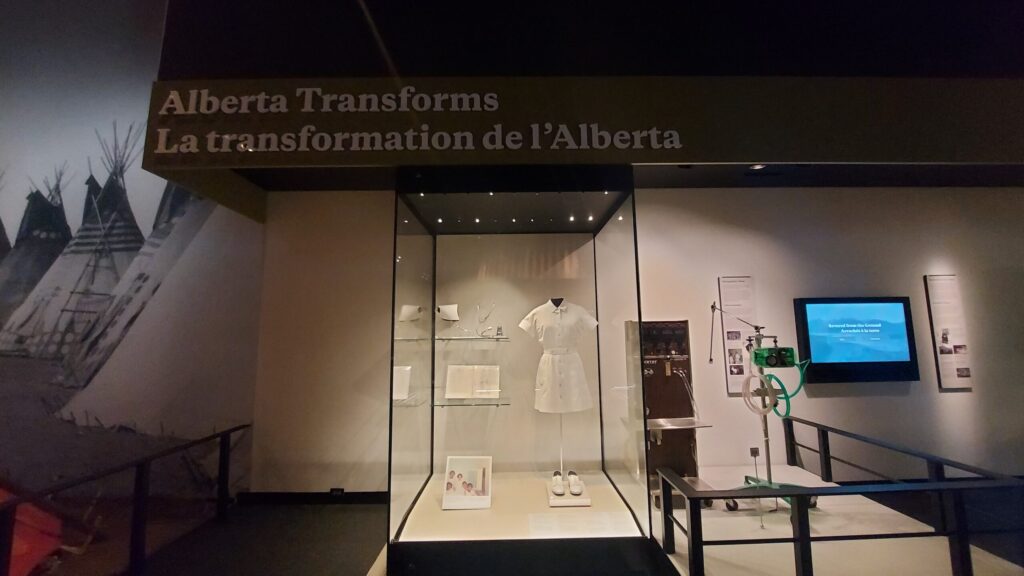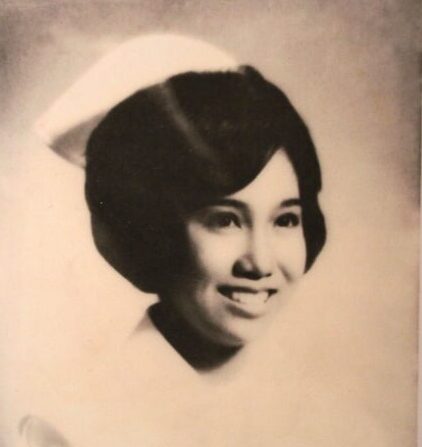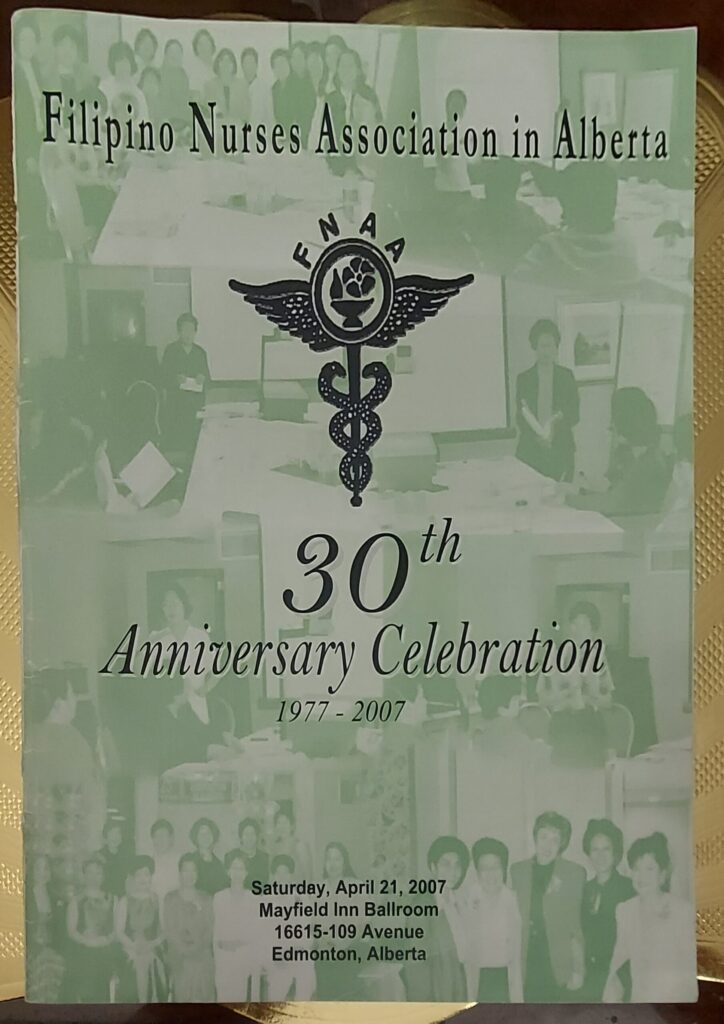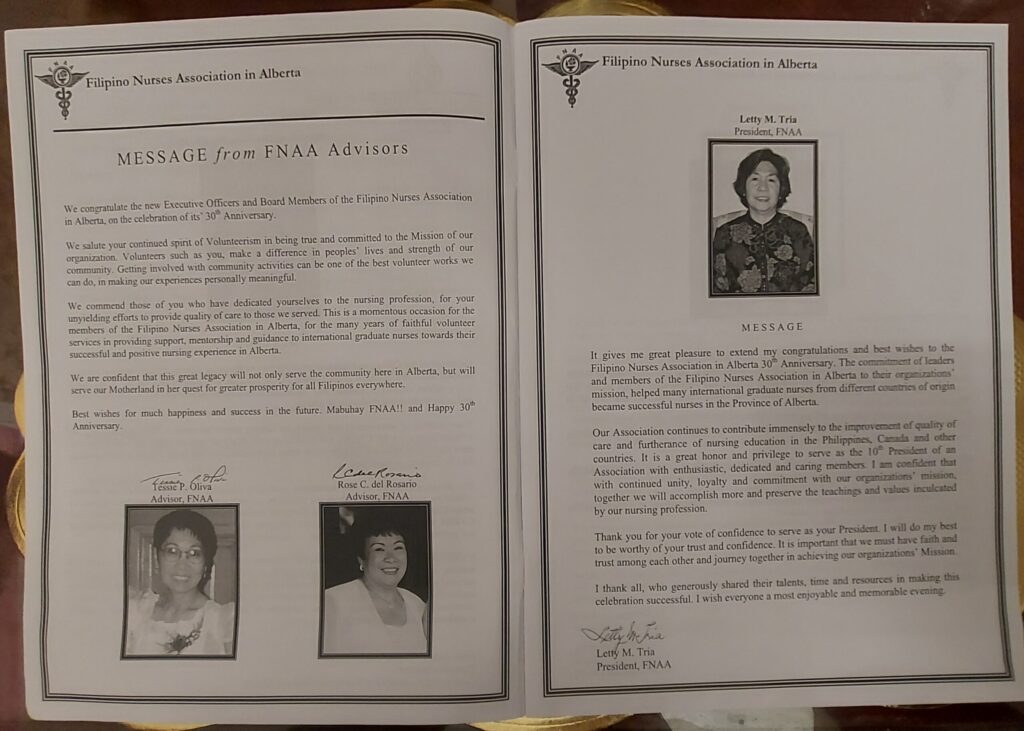In May 2020, for my birthday, my husband and I visited the Royal Alberta Museum in downtown Edmonton, which had recently reopened due to COVID closures earlier that year. As we browsed through exhibits almost devoid of visitors, a display caught my attention. It was a glass case with a nurse’s uniform, cap, stethoscope, and a printed photo of a group of nurses in what seemed like a staff breakroom. To my surprise and delight, it was a fellow Filipino-Canadian.
The museum display exhibited the life and work of Teresita “Tessie” Pajarillo Oliva, a Filipino nurse who is considered to be a great contributor to the development of Edmonton and, more broadly, Alberta. I vaguely recognized the name. As a new columnist for the Alberta Filipino Journal back in 2017, I remembered an article published about her remarkably long list of accolades and accomplishments serving the immigrant community and the city at-large, a list that was recognized even after her death in 2017.[1]


Until I saw the exhibit, I had never encountered the Filipino caregiver stereotype, which had been thrown at me since reaching adulthood, so deliberately displayed. When my body and face matured five years after arriving in Edmonton, the commentary came from everywhere. From taxi rides, community events, bus rides, or casual encounters on public spaces, the first thing strangers ask is whether I’m a caregiver or nurse. If they are not Filipino, they then burst into enthusiastic commentary about how so many Filipinos work in healthcare and how amazing they are. Filipino women are assumed to equal people who give care. This mindset is partly thanks to efforts by the Alberta healthcare sector, the immigration system, and organizers like Tessie to integrate people from a specific nationality into a specific sector.
Tessie Oliva and Supporting IENs in the 1970s
Leticia Tria is Tessie’s longtime friend who still lives in Edmonton, who shared stories and documents of Tessie’s community service work and career. The Royal Alberta Museum staff also gave me deeper insight into how the exhibit was made and all of Tessie’s accomplishments that made her earn such a prime spot in our province’s history displays.

Tessie moved to Edmonton in 1969 after completing her nursing degree from the University of Santo Tomas located in Manila, Philippines.[2] She first worked at the University of Alberta Hospital in the General Medical Unit in 1969.[3] She got involved with the Filipino community at the time while advancing her career in nursing, to the hospital’s head nurse of Neurology and Rheumatology.
For many immigrants, working in Canada might require updating one’s education or training credentials before being able to work in one’s profession in their country of origin. These standards are also applied to the Internationally Educated Nurses (IENs) who arrive in Edmonton.
In the 1970s, the accreditation tests were changing, and Tessie noticed that the IENs were struggling to pass their exams and adjust to working in Canadian hospitals. She consulted with nurses about what they needed to learn and launched the Filipino Nurses Association in Alberta (FNAA) to fill a much-needed service gap.[4]
Filipino nurses arriving in Edmonton were struggling to pass the proper exams in order to get licensed to work. These difficulties can be attributed to the vast differences in curriculum of nursing in the Philippines and Canada. Tessie envisioned a process to help with all the studying needed, such as laboratory work and having instructors to help nurses learn new concepts. And she made this vision a reality. In addition to career assistance, FNAA organized social events and nurtured a community for the nurses throughout the decades.
The Nursing Wave of the 2000s
The demand for nurses continued to grow, and Tessie, along with the FNAA, heeded the call of Alberta Health Services (Capital Health, prior to 2008) to bring more Filipino nurses in Edmonton and organize large-scale recruitment in the Philippines.[5]
Bringing her decades of experience working as a nurse and her understanding of what IENs need to thrive in Edmonton, she got organized. She helped select the recruitment agency and travelled to the Philippines several times to coordinate with the necessary groups.[6] Alongside the board and volunteers from FNAA, the Filipino community mobilized so that these nurses could have a place to stay and enjoy a smooth transition upon arriving in Canada.
Adjusting to a new country could be challenging, so part of the agreement was housing these new arrivals to make sure they would be settled in their neighbourhoods and hospitals. Local residents were incentivised to participate in this process. They were paid $900 to house a newcomer nurse for forty-five days and to help them get settled: responsibilities included accompanying the newcomers while doing errands—such as getting their SIN card, setting a bank account—and helping them become familiar with their neighbourhood and commute, as well as growing more comfortable living in Edmonton, generally.[7]
Tessie worked on this initiative while also working as a full-time nurse, even during her cancer treatment. Between 2006 and 2010, Tessie was directly involved in facilitating the recruitment of 686 nurses from the Philippines. However, according to her longtime friend Leticia, the broader effort may have brought “thousands of nurses” to Canada, with many finding employment in hospitals across Edmonton.[8]
These nurses were provided a temporary visa to work. When these temporary visas were about to expire, Tessie and the FNAA advocated for Permanent Residency status, as the need for nurses is not temporary. They advocated towards all levels of government.
“Good enough to work, good enough to stay,” is a mantra I heard from migrant support organizations in recent years. A sentiment that Tessie also believed at the time.


I listened to Leticia intently at her dinner table, as we browsed through copies of FNAA’s old booklets. She would say with awe. “Tessie is very intelligent. She can move mountains.”
Leticia shared one of many examples of when Tessie did such a thing:
“There’s this one nurse about to leave for the Philippines because her visa expired. Tessie refused to accept that this nurse had to go, so she wanted to fight one more time. She stayed up all night to talk to her contacts and speed up the Permanent Residency processing. And Tessie did it! My goodness, they drove so fast to the airport to stop that nurse from boarding that flight, who got to stay in Edmonton for good!”
Tessie relentlessly encouraged those working as nursing aides to aim higher and advance their careers, to not settle. With a mixture of the blunt and caring nature that one can receive from a Filipino matriarch, she pushed many who are nursing aides to pursue being registered nurses.[9]
Impact on the City and Filipino-Edmontonians
I spoke to Jaime Balmores, one of the hundreds of nurses who came to Canada in the 2000s through Tessie’s collaboration with Capital Health.[10] Jamie worked as a nurse for a few years, until he discovered his passion for cooking and pivoted his career. He launched Jeepney Jaytee, one of the first Filipino-themed food trucks in Edmonton. Whenever Leticia or Tessie would visit the food truck, Jamie would loudly announce to the line of customers waiting for food, “she is the reason why I am here in Canada and I am forever grateful!” Jamie remembers that Tessie would feel touched and slightly self-conscious.
Tessie in the years before her death in 2017—and Leticia in the present-day—constantly ran into the Filipino nurses who came to Canada through their efforts, receiving words of gratitude for the pathway that led them to be established in this country.
While there are no specific statistics counting the number of nurses in Edmonton and in each hospital that are Filipinos, commentary about having Filipinos everywhere in every hospital and healthcare setting underscores the impact of these deliberate efforts by Tessie, the Filipino community, and the healthcare authorities of the time.
FNAA disbanded in 2015, two years before Tessie passed away. A new organization emerged to support IENs in Edmonton, called Internationally Educated Nurses Association of Alberta (IENAA).[11] The need for nurses continues not only in Edmonton, but all over Alberta and Canada, a demand that continues to be filled in large part from immigration.[12]
In my high school years in the Philippines in the mid-2000s, the allure of becoming a nurse, moving to a Western country, and earning dollars was so tantalizing that our elders aggressively pressured us to study nursing. Some of my classmates were threatened by their parents: “Study nursing or we won’t pay for college.”
Now I live in the place where, for the most part, the assumptions held true. The immigrant dream, the transaction and agreements between Philippines and Canada was a win-win as far as Edmonton is concerned. So much so that the assumptions and compliments continue to be thrown at me, a Filipino woman who never worked in the healthcare sector.
My twenty-two-year-old nephew in the Philippines just passed the nursing board exam last summer. I read his social media post saying he has dreams of having a fulfilling career saving lives and making a good life for himself in a Western country. There is a good chance, should international policy and demand continue, that he could be a future Filipino nurse that Edmonton would welcome.
[1] Nicky Gocuan,”Oliva Writes a Page in Alberta’s History,” Alberta Filipino Journal, October 18, 2018, https://www.albertafilipinojournal.com/2018/10/18/oliva-writes-a-page-in-albertas-history/; “Teresita Pajarillo OLIVA Obituary,” Edmonton Journal, accessed February 1, 2025, https://edmontonjournal.remembering.ca/obituary/teresita-oliva-1066254248.
[2] Royal Alberta Museum. “Putting Skills to Work” [Tessie Oliva exhibit]. 2018, Edmonton, Alberta.
[3] “Putting Skills to Work” [Tessie Oliva exhibit]. 2018
[4] “FNAA History,” Filipino Nurses Association of Alberta 30th Anniversary Booklet, 2007, File H14.154, Tessie Oliva Accession File, Royal Alberta Museum, Edmonton, Alberta, Canada.
[5] Research from Tessie Oliva accession file H14.154
[6] Leticia Tria, personal interview with author, October 2020; Royal Alberta Museum. Notes from interview with Tessie Oliva, accession file H14.154.
[7] Leticia Tria, personal interview with author, November 2024.
[8] The figure of 686 nurses is based on interview notes from Tessie Oliva for a museum exhibit, while the estimate of “thousands” reflects the recollection of her longtime friend, Leticia Tria.
[9] Health Care Aides (HCAs) assist with daily living activities like hygiene and mobility, earning an average of $18.53 per hour in Alberta. Registered Nurses (RNs) provide comprehensive patient care, including assessments and medication administration, with an average wage of $46.21 per hour. For more information, see “Health Care Aide,” Alberta Health Services, https://www.albertahealthservices.ca/info/Page8636.aspx; and “Registered Nurse,” https://www.albertahealthservices.ca/info/Page8605.aspx.
[10] Jamie Balmores, personal interview with author, October 2020.
[11] “Internationally Educated Nurses Association of Alberta,” IENAA, accessed December 30, 2024, ienaa.com.
[12] “Record-Breaking Renewal Rates at the College of Registered Nurses of Alberta,” College of Registered Nurses of Alberta (CRNA), accessed March 9, 2025, https://www.nurses.ab.ca/strengthening-the-system/record-breaking-renewal-rates-at-the-college-of-registered-nurses-of-alberta-crna/.
Bibliography
Balmores, Jamie. Personal interview with the author. October 2020.
Filipino Nurses Association of Alberta. FNAA History. 30th Anniversary Booklet, 2007.
Gocuan, Nicky. “Oliva Writes a Page in Alberta’s History.” Alberta Filipino Journal. October 18, 2018. https://www.albertafilipinojournal.com/2018/10/18/oliva-writes-a-page-in-albertas-history/.
“Internationally Educated Nurses Association of Alberta.” Internationally Educated Nurses Association of Alberta (IENAA). Accessed December 30, 2024. https://ienaa.com.
“Record-Breaking Renewal Rates at the College of Registered Nurses of Alberta.” College of Registered Nurses of Alberta (CRNA). Accessed March 9, 2025. https://www.nurses.ab.ca/strengthening-the-system/record-breaking-renewal-rates-at-the-college-of-registered-nurses-of-alberta-crna/.
Royal Alberta Museum. Putting Skills to Work [Tessie Oliva exhibit]. 2018. Edmonton, Alberta, Canada.
Royal Alberta Museum. Research from Tessie Oliva accession file H14.154.
Royal Alberta Museum. Notes from interview with Tessie Oliva, accession file H14.154.
“Teresita Pajarillo OLIVA Obituary.” Edmonton Journal. Accessed February 1, 2025. https://edmontonjournal.remembering.ca/obituary/teresita-oliva-1066254248.
Tria, Leticia. Personal interview with the author. October 2020.
Tria, Leticia. Personal interview with the author. November 2024.
